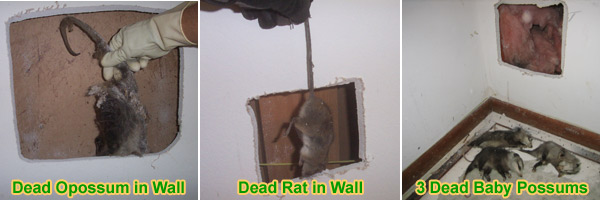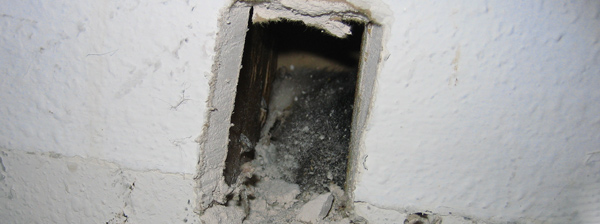- info@wildlife-removal.com
Call us for help in your town
Wildlife Removal Education
Dead Animal In the Wall
Need animal removal in your hometown? We service over 500 USA locations! Click here to hire us in your town and check prices - updated for year 2020.
If the dead animal is in the wall, then I've got to cut it out, plain and simple. In rare cases, I'm able to go up in the attic and look down the wall and use a
special snare tool or grasping tool to get the dead animal, but most of the time I've got to cut a hole.
Click here for a nationwide list of 100's of professional wildlife trappers serving all 50 states.

In order to find the exact spot where I need to cut a hole in the wall, I have to sniff and sniff. If I've narrowed down the area, and the animal is not
in the attic or under the house and definitely inside the wall cavity, I stick my nose right on the wall and sniff every square inch until I hit the exact spot. Believe me,
when I get to that spot, I know it. The smell is not only stronger, but it changes in nature. The wall is even sometimes slightly warm due to the slow combustion
process of decomposition. So when I find that spot, I cut a hole open and remove the animal.
Sometimes an animal just falls down a wall, and can't get out. I've seen this happen with mice, rats, squirrels, opossums, and raccoons. The walls of drywall are very smooth, and
hard to climb. If you hear scratching at the bottom of a wall, you'd better do something about it, or the animal will suffer and die, and then cause an odor that you don't want.
Once I remove the dead animal(s), I mop up any bodily fluids and maggots, I remove any soiled insulation, and I spray down the area with a special enzyme-based cleaner
that destroys biohazard waste. The removal of the dead carcass is 90% of the problem, of course, and if you let the house air out after that, (opening windows helps) the
odor will be gone very quickly. If you don't remove the dead animal, the horrible stink will remain in your house until the animal completely decomposes and gets
eaten by maggots, and the whole process will take a little more than a week with a small animal like a mouse or rat, and over a month with a big animal like a raccoon
or opossum. I do recommend that you have the animal removed. The bad smell will go away within an hour.
I also always patch up the hole that I cut open. I cut at an angle to save the piece of drywall, and I bolt it back in place and spackle the edges, or I just use a
spackle drywall patch.
For more information about dead animal removal from various areas, read the below articles.
Dead Animal Removal
Bad Smell in House
Dead Animal in Chimney
Dead Animal in Attic
Dead Animal in Duct or Vent
My name is David, and I am an expert on dead critter carcass extraction from homes and buildings. If you have a deceased animal in your house, I can remove it. If you don't live
near me, click on my home page, and I have listed hundreds of wildlife removal companies who specialize in dead wildlife body removal, odor control, waste removal, and deodorization.
Dead Animal Email Sent to Me:
Me and my husband noticed a bad smell in the bathroom. So he went up into the attic to see if it was a dead animal. It may be a dead rat. He found it in between the wall and today try to pick it out. He got fur, but that's about it.
Well now we have maggots coming out from behind the fridge. Which is the same wall. I can't see where they are coming from but the smell is coming from the plug in the wall. He can't seem to reach it from the attic.
I was wondering how much it would be for a removal out of a wall? Can you help with this? We live in Tampa not Orlando. Will that be a problem? Thanks, Jennifer
My response: I have a friend in Tampa who can definitely come and remove the dead animal in your wall.
Dead Animal Email Sent to Me: Hello: My super tried in vain to locate the carcass of a dead rat or mouse lodged within the walls or floor of my apartment. I've tolerated several days of stench while the super made his best effort and we've decided to disguise the odor and allow for full decomposition to occur "naturally," with hope of no personal health consequences. Is this advisable? Rsvp. Yours truly, Hugh Lynch,,, New York, New York.
My response: Sure! If you can stand the stink, just wait it out for a week or two, and the smell will be gone. There are no health risks that I know of.
Cutting A Dead Animal From A Wall
The most noticeable indication that you may have a dead animal inside the wall is that the smell is often very strong or overpowering, and this can also affect the activity of any domestic pets within the home. In some cases you may be able to remove the carcass by gaining access through a vent or a space at the top of a wall cavity, but in some cases you will have no choice but to cut into the wall to remove the dead animal. Make sure that you have all of the supplies to carry out the repairs before you start to carry out the work.

Choosing The Location To Make The Cut
Although you can detect where the smell of the animal is likely to be strongest, in many cases it will be difficult to identify exactly where the carcass is if you cannot see inside the wall cavity. In this case make the cut fairly low on the wall, and make it large enough to give you some room to move inside the cavity if the carcass is a little to the left or right of the hole. Try to cut the hole in a regular shape such as a square, as this will help you when it comes to the repair.
Removing The Carcass
The carcass itself can be quite difficult to remove, particularly if it is a little away from where you cut the hole, but make sure you are wearing gloves and long sleeved clothing, in case any parasites such as ticks and fleas remain on the dead animal. A grabber stick can be useful in this situation to get any animal that is difficult to get to. Place the dead animal into a thick plastic bag or a plastic container that has an airtight seal, and if using a plastic bag double bag it to prevent the scent from escaping. This can then be incinerated, or for smaller animals it can be placed in the garbage.
Repairing The Hole In The Wall
Having cut the hole in the drywall, the repair will depend on the size of the hole and your DIY experience, as the larger the hole the more difficult it is to repair. There are patches that can be purchased tocover small holes, but for holes of more than a couple of inches, you will need to cut a piece of drywall to the size of the hole, and with a few inches of paper around the edges, this can be glued into place, and then cover the edges with filler before sanding and repainting the area.
br>
Go back to the Wildlife Removal home page.


















